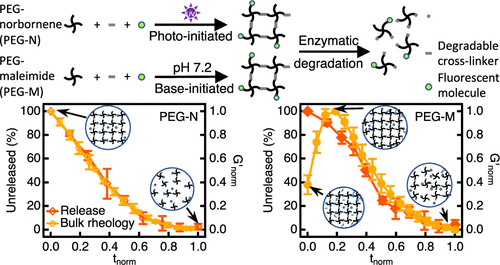当前位置:
X-MOL 学术
›
Biomacromolecules
›
论文详情
Our official English website, www.x-mol.net, welcomes your
feedback! (Note: you will need to create a separate account there.)
Correlation of Bulk Degradation and Molecular Release from Enzymatically Degradable Polymeric Hydrogels
Biomacromolecules ( IF 5.5 ) Pub Date : 2021-09-13 , DOI: 10.1021/acs.biomac.1c00719 Nan Wu 1 , Kelly M Schultz 1
Biomacromolecules ( IF 5.5 ) Pub Date : 2021-09-13 , DOI: 10.1021/acs.biomac.1c00719 Nan Wu 1 , Kelly M Schultz 1
Affiliation

|
In this work, we establish a quantitative correlation between molecular release and material degradation. We characterize a radical-initiated photopolymerized hydrogel and base-initiated Michael addition-polymerized hydrogel, which form gels through distinct crosslinking reactions. Both scaffolds use the same degradable peptide crosslinker, which enables them to be degraded through the same enzymatic degradation reaction. A fluorescently labeled poly(ethylene glycol) molecule is chemically conjugated into the scaffold and is released during enzymatic degradation. Real-time changes in scaffold rheological properties during degradation are measured using bulk rheology. Molecular release is measured by quantifying the change in fluorescence in the incubation liquid and the hydrogel scaffold. A complicating factor, previously described in the literature, is that shear may cause increased crosslinking, resulting in an increase in the storage modulus after initiation of degradation, which changes release profiles by limiting the initial release of molecules. Therefore, we also test the hypothesis that shear induces additional crosslinking in degrading hydrogel scaffolds. To determine whether shear changes rheological properties during scaffold degradation, enzymatic degradation is characterized using bulk rheology as materials undergo continuous or minimal shear. To determine the effect of shear on molecular release, shear is induced by shaking the material during incubation. Release is characterized from scaffolds that are incubated with continuous or without shaking. We determine that shear does not make a difference in scaffold degradation or release regardless of the gelation reaction. Instead, we determine that the type of hydrogel crosslinking reaction greatly affects both material degradation and molecular release. A hydrogel crosslinking by base-initiated Michael addition does undergo further crosslinking at the start of degradation. We correlate release with enzymatic degradation for both scaffolds. We determine that the material storage modulus is indirectly correlated with release during degradation. These results indicate that rheological characterization is a useful tool to characterize and predict the release of molecules from degrading hydrogels.
中文翻译:

酶促降解聚合物水凝胶的整体降解和分子释放的相关性
在这项工作中,我们建立了分子释放和材料降解之间的定量相关性。我们表征了自由基引发的光聚合水凝胶和碱引发的迈克尔加成聚合水凝胶,它们通过不同的交联反应形成凝胶。两种支架都使用相同的可降解肽交联剂,这使它们能够通过相同的酶促降解反应进行降解。荧光标记的聚(乙二醇)分子通过化学方式结合到支架中,并在酶促降解过程中释放。使用体积流变学测量降解过程中支架流变特性的实时变化。通过量化孵育液和水凝胶支架中荧光的变化来测量分子释放。一个复杂的因素,先前在文献中描述的是,剪切可能导致交联增加,导致降解开始后储能模量增加,这通过限制分子的初始释放来改变释放曲线。因此,我们还测试了剪切在降解水凝胶支架中引起额外交联的假设。为了确定在支架降解过程中剪切是否会改变流变特性,当材料经历连续或最小剪切时,使用体积流变学表征酶促降解。为了确定剪切对分子释放的影响,通过在孵育过程中摇动材料来诱导剪切。释放的特点是在连续或不摇动的情况下孵化的支架。我们确定无论凝胶反应如何,剪切不会对支架降解或释放产生影响。相反,我们确定水凝胶交联反应的类型极大地影响材料降解和分子释放。通过碱引发的迈克尔加成交联的水凝胶在降解开始时会发生进一步的交联。我们将释放与两种支架的酶降解相关联。我们确定材料储能模量与降解过程中的释放间接相关。这些结果表明流变学表征是表征和预测分子从降解水凝胶中释放的有用工具。我们确定水凝胶交联反应的类型极大地影响材料降解和分子释放。通过碱引发的迈克尔加成交联的水凝胶在降解开始时会发生进一步的交联。我们将释放与两种支架的酶降解相关联。我们确定材料储能模量与降解过程中的释放间接相关。这些结果表明流变学表征是表征和预测分子从降解水凝胶中释放的有用工具。我们确定水凝胶交联反应的类型极大地影响材料降解和分子释放。通过碱引发的迈克尔加成交联的水凝胶在降解开始时会发生进一步的交联。我们将释放与两种支架的酶降解相关联。我们确定材料储能模量与降解过程中的释放间接相关。这些结果表明流变学表征是表征和预测分子从降解水凝胶中释放的有用工具。我们确定材料储能模量与降解过程中的释放间接相关。这些结果表明流变学表征是表征和预测分子从降解水凝胶中释放的有用工具。我们确定材料储能模量与降解过程中的释放间接相关。这些结果表明流变学表征是表征和预测分子从降解水凝胶中释放的有用工具。
更新日期:2021-11-08
中文翻译:

酶促降解聚合物水凝胶的整体降解和分子释放的相关性
在这项工作中,我们建立了分子释放和材料降解之间的定量相关性。我们表征了自由基引发的光聚合水凝胶和碱引发的迈克尔加成聚合水凝胶,它们通过不同的交联反应形成凝胶。两种支架都使用相同的可降解肽交联剂,这使它们能够通过相同的酶促降解反应进行降解。荧光标记的聚(乙二醇)分子通过化学方式结合到支架中,并在酶促降解过程中释放。使用体积流变学测量降解过程中支架流变特性的实时变化。通过量化孵育液和水凝胶支架中荧光的变化来测量分子释放。一个复杂的因素,先前在文献中描述的是,剪切可能导致交联增加,导致降解开始后储能模量增加,这通过限制分子的初始释放来改变释放曲线。因此,我们还测试了剪切在降解水凝胶支架中引起额外交联的假设。为了确定在支架降解过程中剪切是否会改变流变特性,当材料经历连续或最小剪切时,使用体积流变学表征酶促降解。为了确定剪切对分子释放的影响,通过在孵育过程中摇动材料来诱导剪切。释放的特点是在连续或不摇动的情况下孵化的支架。我们确定无论凝胶反应如何,剪切不会对支架降解或释放产生影响。相反,我们确定水凝胶交联反应的类型极大地影响材料降解和分子释放。通过碱引发的迈克尔加成交联的水凝胶在降解开始时会发生进一步的交联。我们将释放与两种支架的酶降解相关联。我们确定材料储能模量与降解过程中的释放间接相关。这些结果表明流变学表征是表征和预测分子从降解水凝胶中释放的有用工具。我们确定水凝胶交联反应的类型极大地影响材料降解和分子释放。通过碱引发的迈克尔加成交联的水凝胶在降解开始时会发生进一步的交联。我们将释放与两种支架的酶降解相关联。我们确定材料储能模量与降解过程中的释放间接相关。这些结果表明流变学表征是表征和预测分子从降解水凝胶中释放的有用工具。我们确定水凝胶交联反应的类型极大地影响材料降解和分子释放。通过碱引发的迈克尔加成交联的水凝胶在降解开始时会发生进一步的交联。我们将释放与两种支架的酶降解相关联。我们确定材料储能模量与降解过程中的释放间接相关。这些结果表明流变学表征是表征和预测分子从降解水凝胶中释放的有用工具。我们确定材料储能模量与降解过程中的释放间接相关。这些结果表明流变学表征是表征和预测分子从降解水凝胶中释放的有用工具。我们确定材料储能模量与降解过程中的释放间接相关。这些结果表明流变学表征是表征和预测分子从降解水凝胶中释放的有用工具。











































 京公网安备 11010802027423号
京公网安备 11010802027423号